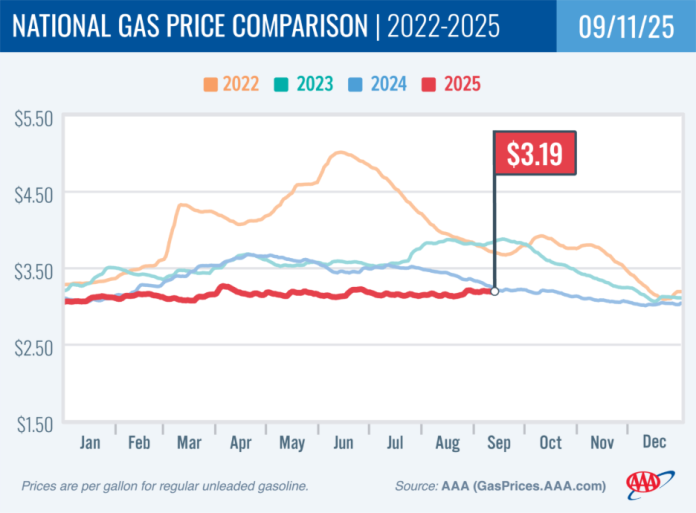As autumn settles in, small business owners are starting to see changes at the gas pump, which can significantly impact operating costs. According to the latest data from AAA, gas demand is decreasing as drivers shift into fall routines, making way for the potential of lower pump prices. The current national average price for a gallon of regular gasoline has dipped slightly to $3.19.
The dynamics behind this shift are compelling. With an abundance of crude oil supply overshadowing demand, the market appears stable for now. Additionally, the transition to winter-blend gasoline, which is cheaper to produce, is beginning. “We are entering a period where prices could stabilize or even decrease,” noted a representative from AAA.
However, not all regions are feeling this relief. The Pacific Northwest is currently experiencing a notable spike in prices, with gas costs rising over 20 cents in just a week due to the temporary shutdown of a major fuel pipeline connecting Washington to Oregon. This pipeline is expected to resume operations shortly, easing pressure on local prices.
Key Statistics on Gas Prices
- Current National Average: $3.194
- Price One Week Ago: $3.201
- Price One Month Ago: $3.138
- Price One Year Ago: $3.253
For small business owners, these fluctuations in gas prices can impact various operational aspects, from delivery costs to employee travel reimbursements. With gasoline demand dropping from 9.11 million barrels per day to 8.50 million, overall fuel expenditure may lessen for businesses that rely on road transport.
Total domestic gasoline supply has seen a slight increase from 218.5 million barrels to 220 million, despite a drop in production to an average of 9.6 million barrels per day. These statistics may imply that while the price per gallon could fall, the supply is still robust enough to support sustainable business operations.
And while gasoline prices vary widely across the country, some states are certainly feeling the pinch more than others. For example, prices in California are reported at $4.63 per gallon, while states like Mississippi see much lower rates at $2.71. This disparity highlights a critical opportunity for small business owners to evaluate their location-based fuel strategies. Cost-saving measures such as optimizing delivery routes and encouraging remote work for employees could help maintain profitability in the face of fluctuating fuel costs.
Electric Vehicles and Charging Infrastructure
Transitioning to alternative fuel sources also presents a valuable avenue for small businesses looking to mitigate fuel costs. The cost per kilowatt-hour for public EV charging stations has remained steady at 36 cents, which may be attractive for businesses considering electric vehicles as part of their fleet. Notably, states with lower charging costs include Kansas at 25 cents per kilowatt-hour, presenting a more budget-friendly option for businesses in those areas.
As electric vehicles become more prevalent, small businesses should explore the feasibility of incorporating EVs into their operations. This transition could not only reduce fuel costs but also enhance brand image as companies shift towards more sustainable practices.
The Broader Implications
While many small business owners may welcome lower gas prices, the anticipated decrease could be outweighed by external factors. For instance, geopolitical events, seasonal demand shifts, and even infrastructure issues can all exert pressure on gas and diesel prices. The recent pipeline issues in the Pacific Northwest exemplify how localized supply chain disruptions can create significant price fluctuations, often impacting smaller businesses more acutely due to their typically tighter margins.
Furthermore, small business owners should stay updated on trends in energy markets and examine the potential of renewable energy initiatives. Such adjustments could lead to long-term savings and sustainability.
As circumstances evolve, business owners can track current gas and electric charging prices along their routes through resources like the AAA TripTik Travel planner, ensuring they stay well-informed about the most economical fueling options available.
For more detailed insights and updates, you can visit the original post here.
Image Via Gas Price



